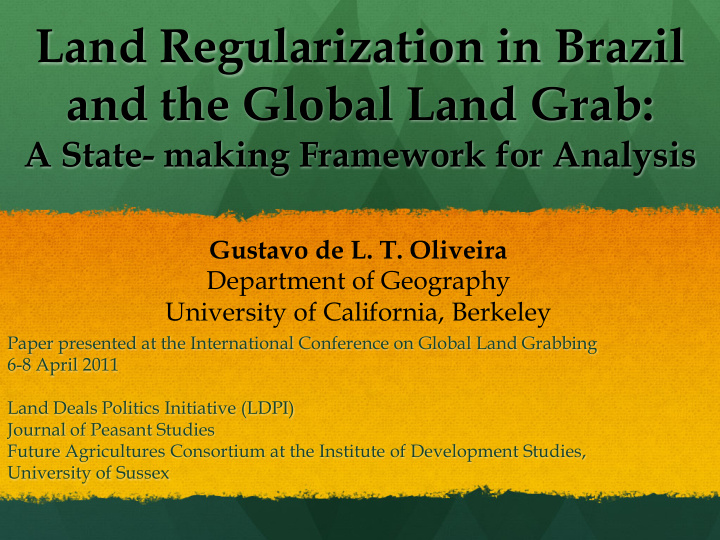



Land Regularization in Brazil and the Global Land Grab: A State- making Framework for Analysis Gustavo de L. T. Oliveira Department of Geography University of California, Berkeley Paper presented at the International Conference on Global Land Grabbing 6-8 April 2011 Land Deals Politics Initiative (LDPI) Journal of Peasant Studies Future Agricultures Consortium at the Institute of Development Studies, University of Sussex
The Cerrado Ecosystem Boundaries as defined by WWF Open source image by Pfly, Wikipedia
Spatial distribution of sugar-cane production, 2008 Source: “Agrarian structure, foreign land ownership, and land price in Brazil” Sérgio Sauer & Sergio Pereira Leite (Panel 13)
Spatial distribution of soybean production, 2008 Source: “Agrarian structure, foreign land ownership, and land price in Brazil” Sérgio Sauer & Sergio Pereira Leite (Panel 13)
Percentage of foreign-owned land by state, 2003 Source of data: INCRA Image: Folha de São Paulo
The Terra Legal Regularization Program Initiated by the Ministry of Rural Development (MDA) in June 2009. Intended to regularize in three years titles of 300.000 homesteaders in yet-unassigned public land in the Amazon region (both urban and rural). Could affect up to 670 thousand square kilometers (equivalent to the total area of Germany and Poland combined). Properties to be regularized must have been occupied since at least December 1 st , 2004. Holdings up to 1,500 hectares are eligible. Four stages: registration, georeferencing, field inspection, and titling.
Land eligible for Regularization Source: IMAZON / Brito & Barreto 2010
Terra Legal: current status As of March 31, 2011 Holdings registered : 88.029 Total area : 10,337,871 hectares A little larger than Portugal or Hungary, about the size of Iceland Holdings titled : 440 Area titled : 75,734 hectares Half the size of London, about the size of Bahrain
Terra Legal: current status 63% of petitions registered during the first year fall at or below 76 hectares and amount to only 16% of the total area registered for regularization. Consider urban and peri-urban holdings 8% of the petitions registered for holdings between 400 and 1500 hectares account for 39% of the total area . Concentration has increased since the first year
Spatial distribution of regularizations by stage January, 2011 Rural Registration Rural Georeferencing Rural Titling Urban Registration Urban Georeferencing Urban Titling Source: MDA
Problems with regularization (A) Prior limit of 100 he for regularization was increased to 1,500 he in 2008 due to pressure from extractivist industries. Concentration of land by largest properties, and risk of consolidation by families or purchase. Properties larger than 400 he can be re-sold in 4 years, while those smaller than 400 he can only be re-sold in 10 years. Terra Legal process taking place faster than (and may trample) processes of recognizing/regularizing community rights of indigenous and other traditional populations. Privatization below market price, without field-inspections for properties below 400 he, and without fines for illegal logging.
Problems with regularization (B) Diversion of human and financial resources from agrarian reform, encouraging further colonization of marginal lands instead of land redistribution. Even if implementation of the program curtails deforestation and land concentration at first, it sets the conditions for increased deforestation and land concentration in the future. Consolidation of agribusiness production in Cerrado through renewed infrastructure and production along transportation corridors to Amazon-river ports and waterways. Integration of the Amazon-Cerrado transition zone into the agribusiness production system.
Conclusions It is impossible to comprehend the dynamics of these processes without reference to the key role played by the Brazilian state, on the one hand limiting foreign land grabs and investments, but on the other hand facilitating the consolidation of Brazilian agribusiness production and its insertion into the global market. International tendencies and processes identified as a global land grab are accepted yet modified by Brazilian capitalists, subverted but not yet overturned by Brazilian agents.
Conclusions The Cerrado-Amazon transition zone is the keystone to the land grabbing currently taking place in Brazil, linking together two seemingly distinct and contradictory state policies in the consolidation of the agribusiness production system. The greater imposition of legibility over the Amazon might indeed curtail deforestation and land concentration, in so far as it is possible to intensify and concentrate capitalist agribusiness production while accommodating environmental and social reforms . Yet the greater legibility of the Cerrado and its transition into the Amazon actually result in greater deforestation and land concentration, since the state is ultimately attending to capitalist agribusiness and extractivist interests. Discussion of regularization must consider the pros and cons of agricultural intensification along transportation corridors.
Conclusions On the one hand, an increase in state-making alongside transportation corridors through regularized property relations, could actually transform an ensuing failure of the Terra Legal program into the test ground for a new agroecological basis for Brazilian progress. On the other hand, a concession to agribusiness and extractivist interests in the keystone Amazon-Cerrado transition zone could ultimately consolidate capitalist exploitation in the Amazonian fringe and forestall more radical demands for agrarian reform in the Cerrado and other highly populated and farmed regions elsewhere in the country, in a classic process of accumulation by dispossession.
Land Regularization in Brazil and the Global Land Grab: A State- making Framework for Analysis Gustavo de L. T. Oliveira Department of Geography University of California, Berkeley oliveira@berkeley.edu
Recommend
More recommend